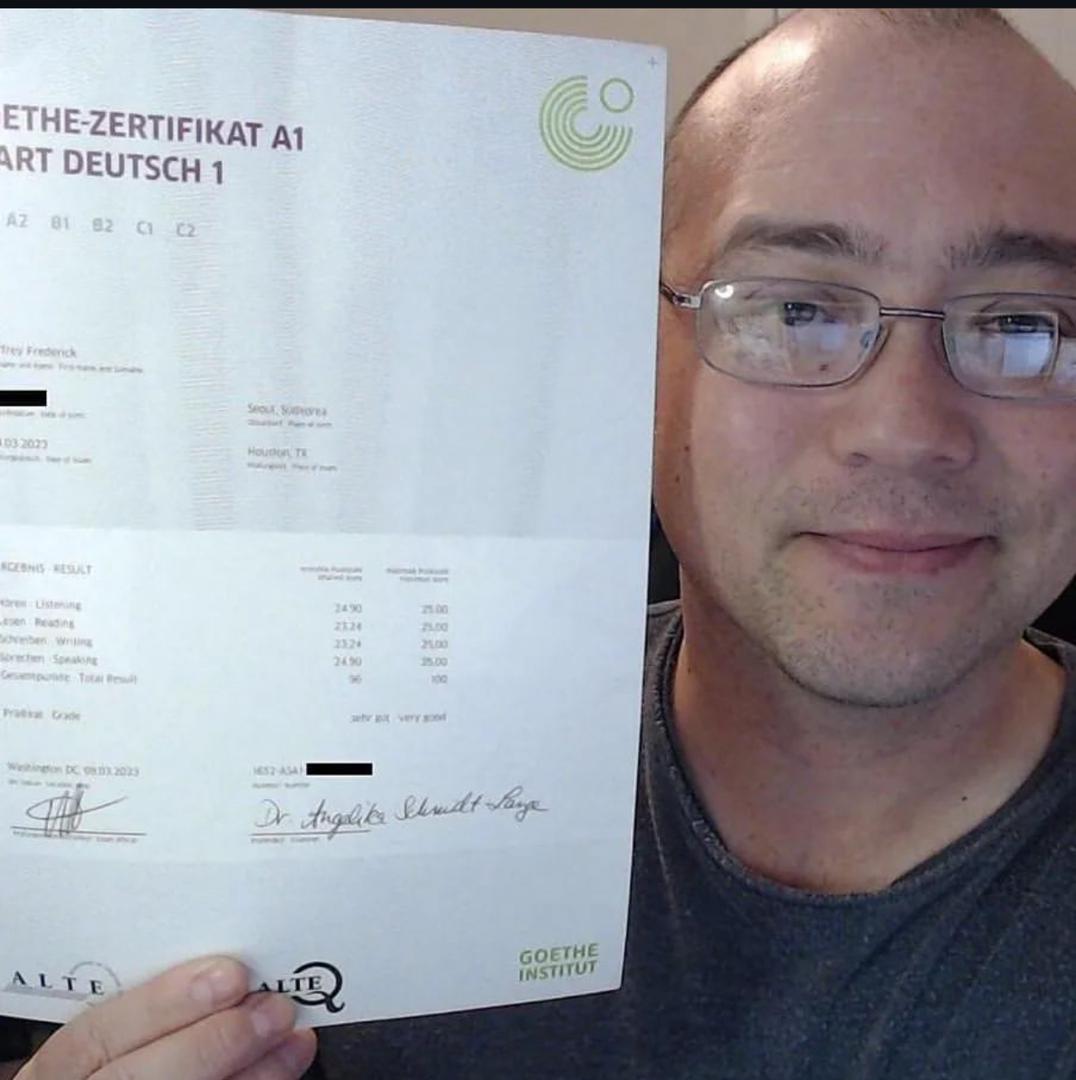11 "Faux Pas" That Actually Are Okay To Make With Your A2 Ce…
페이지 정보

본문
 A2 Certificate German: Your Step-by-Step Guide to Language Proficiency
A2 Certificate German: Your Step-by-Step Guide to Language ProficiencyThe ability to interact efficiently in another language is a valuable skill in today's significantly interconnected world. For people desiring live, work, or study in German-speaking nations, attaining the A2 certificate in German is a substantial turning point on their journey to language proficiency. It confirms one's basic understanding of the German language and culture, opening opportunities for integration, öSd Grundstufe employment, and further knowing.
This short article offers a thorough guide to comprehending the A2 certificate in German, including its significance, exam format, pointers for ÖSD-Zertifikat A1 preparation, and frequently asked questions.
What Is the A2 Certificate in German?
The A2 certificate in German is the second proficiency level in the Common European Framework of Reference for Languages (CEFR). The CEFR is a worldwide recognized requirement that measures language proficiency on a scale from A1 (beginner) to C2 (mastery).
At the A2 level, learners:
Grasp basic expressions and osd Zertifikat einfuhrung expressions used in everyday situations.
Interact easy concepts connected to familiar subjects such as family, work, shopping, and travel.
Understand frequently utilized sentences in locations of immediate importance, like individual details or local location.
Make up short, basic messages and react to familiar conversations.
This certificate is frequently a prerequisite for people seeking home in Germany, Austria, or Switzerland, making an application for civic integration courses, or pursuing German citizenship.
Who Needs the A2 Certificate in German?
The ösd a2 certificate serves various functions depending on a person's objectives. It is frequently needed for:
Combination Programs: Many German-speaking countries mandate A2 proficiency for immigrants enrolling in cultural or language integration courses.
Visa and Residency Applications: An A2 certificate may belong to the requirements for long-lasting residency or household reunification visas.
Educational Advancements: Students aiming for higher CEFR levels (e.g., osd Zertifikat einfuhrung B1 or ÖSD-Zertifikat B2) often start with an A2 certificate to validate their progress.
Employment Opportunities: Some tasks in the German labor market expect prospects to show at least A2 proficiency, especially for functions in customer-facing positions.
Structure of the A2 German Exam
Comprehending the format of the A2 German exam is essential for reliable preparation. The test examines your listening, reading, writing, and speaking skills.
1. Listening (Hören).
Period: 20-- 30 minutes.
Content: You'll listen to short discussions, statements, and daily discussions, followed by concerns.
Objective: Assess the capability to understand vital details in typical scenarios like shopping or traveling.
2. Reading (Lesen).
Period: 30 minutes.
Material: Exam questions concentrate on short texts such as e-mails, ads, sales brochures, or notices.
Goal: Test understanding of standard written German in real-life contexts.
3. Composing (Schreiben).
Period: 30 minutes.
Material: Tasks consist of composing short messages, completing types, or composing easy letters.
Goal: Evaluate your ability to articulate ideas using standard syntax.
4. Speaking (Sprechen).
Period: 15 minutes.
Material: The session consists of brief introductions, addressing personal questions, and role-playing dialogues.
Goal: Test your capability to communicate on familiar topics in quick exchanges.
Each section is scored separately, and your general grade will reflect your efficiency across these areas.
How to Prepare for the A2 German Exam.
Accomplishing success on the A2 German exam requires tactical preparation. Here are some practical tips to start:.
1. Use Authentic Study Materials.
Describe books like "Menschen A2" or "Schritte Plus A2" created particularly for German learners.
Access online platforms like Goethe-Institut, LingQ, or Duolingo to practice vocabulary and grammar.
2. Practice Listening Regularly.
Tune in to German radio stations, podcasts, or YouTube channels concentrated on newbie and A2-level material.
Acquaint yourself with the German accent and different ways of phrasing everyday discussions.
3. Broaden Vocabulary.
Create flashcards for typical words and expressions.
Focus on practical topics such as time, weather condition, greetings, food, transportation, and shopping.
4. Sign Up With Language Groups.
Take part in German language meetups or exchange groups in your city or online.
Speaking practice with native speakers or fellow students will improve your fluency.
5. Mock Exams and Tests.
Take practice tests to familiarize yourself with the exam format and time constraints.
Numerous language institutes and online forums offer sample A2 tests with responses.
6. Register in a Course.
Join a course at a Goethe-Institut center or Osd Zertifikat Einfuhrung another reliable language school.
These programs supply structured lessons, expert assistance, and personalized feedback.
Benefits of an A2 Certificate in German.
For those who question whether making an A2 certificate is worth the effort, here are a few of the benefits that come with this accomplishment:.
Improved Communication: You'll gain self-confidence in navigating every day life in German-speaking nations.
Cultural Integration: Understanding German opens doors to engaging with local traditions, custom-mades, and events.
Resume Boost: An A2 certificate improves your qualifications and reliability in the task market.
Structure for Advanced Learning: Completing the A2 level sets a strong groundwork for achieving higher CEFR language levels.
Fulfills Legal Requirements: In some cases, holding an A2 certificate is a legal requirement for visa or residency applications.
Frequently asked questions.
1. What is the passing rating for an A2 German exam?
The passing score depends on the screening institute. Usually, you require to score around 60% or greater in each area to pass.
2. The length of time does it take to prepare for the A2 German exam?
On average, learners spend 150-- 200 hours of study time to reach the A2 level. This timeline can vary based on private abilities and methods of knowing.
3. Where can I take the A2 German exam?
The A2 exam is provided by numerous language organizations, including the Goethe-Institut, TELC, and ÖSD. Tests can be taken in qualified centers worldwide.
4. Is the A2 certificate legitimate for life?
Yes, unlike some professional accreditations, the A2 language certificate does not end. Nevertheless, ongoing practice is suggested to keep your abilities.
5. Can I skip the A2 exam and go directly to B1?
Yes, it's possible to take the B1 exam without finishing A2. However, showing understanding at lower levels like A2 offers a structured learning development.
Final Thoughts.
The A2 certificate in German is more than just a document-- it is a testimony to your devotion and ability to immerse yourself in a new language and culture. Whether you're pursuing personal objectives, legal requirements, or career goals, this credential symbolizes a crucial action toward accomplishing higher fluency in German. By preparing strategically and making use of trusted resources, learners can with confidence approach the A2 exam and unlock a world of chances.
 So, are you prepared to start your A2 German journey? Start today, and take one action better to linguistic and cultural proficiency!
So, are you prepared to start your A2 German journey? Start today, and take one action better to linguistic and cultural proficiency!- 이전글10 Facts About Language Test That Will Instantly Set You In A Positive Mood 25.02.18
- 다음글One Of The Most Innovative Things Happening With Buy A German Shepherd 25.02.18
댓글목록
등록된 댓글이 없습니다.